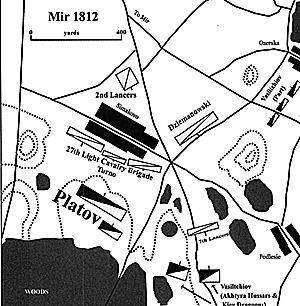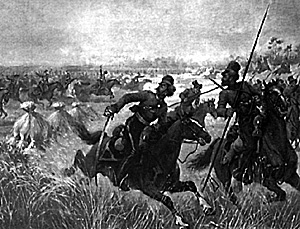Cavalry Skirmishes
Around and About Mir
Polish Cavalry vs. Russian Cossacks
by Richard Alley, UK
| |
As the French Grande Armée began its invasion of Russia the Russian 1st and 2nd Armies of the West were marching towards each other to meet the common threat. However the direction of the main thrust of the French made such a consolidation impossible. Bagration ordered his army to march in the general direction of Minsk with the intention of then marching north to join up with the 1st army somewhere west of Smolensk. Napoleon, on reaching Vilna, ordered Davout with a large task force to march south to intercept and destroy Bagration, although he had no certain intelligence of the latter's true position or strength. Napoleon had already ordered his brother Jerome to march his forces consisting of V and VII Corps and IV Cavalry Corps to chase Bagration. It was now Napoleon's intention that Jerome should join up with Davout, who was then, unbeknown to Jerome, to take command. Jerome's army wing crossed the Niemen later than Napoleon had anticipated and was in no position to pin the Russians and thus allow Davout to engage. However by the 9th July the leading elements of Latour-Maubourg's IV Cavalry Corps caught up with Bagration's rearguard at the village of Korelitchi. The action began when the 3rd Polish Lancers advanced from Korelitchi towards a small village called Piasotchna. Having thrown out the Cossack pickets the lancers traversed the village at the gallop and still in column encountered the first of the Cossack regiments waiting on the near side. Attacked on all sides the 3rd was nearly wiped out. General of Brigade Turno threw in the rest of his brigade, the 15th and 16th Lancers, who held off the Cossacks, and was then reinforced by General of Brigade Dziewanowski's brigade consisting the 2nd, 7th, and 11th Lancers. At the same time the Cossacks were themselves reinforced by the arrival of Generalmajor Vasiltchikov's regular units, the Akhtyrsk Hussars, Lithuanian Uhlans, and the Kiev and New Russia Dragoon regiments and the 5th Jager regiment. However nightfall now put an end to the action which was to continue next day. On the 10th the Russian rearguard consisted of the Hussar and two Dragoon regiments mentioned above along with 4 Cossack regiments and 2 horse artillery batteries all deployed to protect the road to Mir, the rest of the Cossacks where deployed in such a way as to able to ambush the Polish cavalry as it attempted to engage. The Poles were all around a village called Simakovo, save the 7th Lancers who were ordered to advance on the Russian rearguard. Outnumbered the 7th withdrew, and the Russians then attacked the 3rd, 15th, and 16th Lancers. The Poles were reinforced by elements of the Polish V Corps that was now arriving, in particular the 4th Light Cavalry Division under Kaminski although only the Polish 4th Chasseur a Cheval regiments seems to have been engaged. The skirmish continued for about six hours during which several charges and counter charges were made by both sides. In the end the Russians who had had the best of the affair withdrew, as it became clear that more enemy forces were approaching. Casualties over the two days were approximately 1000 killed wounded or captured on the Allied side and about half that figure for the Russians although at least two Cossack colonels were killed. In so many wargaming rules Cossacks seem to stand little chance against regular cavalry but in this particular case they would appear to have done very well indeed. Please recall however that the Polish cavalry was in a very fatigued condition and although eager to fight were unable to withstand the onslaught of the much larger and fresher Russian rearguard. The condition and morale of each side must therefore be taken into consideration when setting up this wargame. I am, as most people who know me or have read my input to First Empire, a ardent "Empire" player, however I would be the first to admit that this scenario to not really a large enough encounter to allow the rules to shine. I would therefore be most grateful if anyone out there who plays this scenario using another set of rules would write in or e-mail First Empire or me (Dave knows my address) and relate its outcome. I hope to write another piece on the larger action, which took place at Saltanovka when Davout caught up with Bagration or was it the other way round! Order of Battle Allied Forces4th Light Cavalry Division, IV Cavalry Corps
28th Light Cavalry Brigade: General of Brigade Dziemanowski
7thPolish Lancer Regiment 11th Polish Lancer Regiment 27th Light Cavalry Brigade: General of Brigade Turno
15th Polish Lancer Regiment 16th Polish Lancer Regiment also in attendance:
1 Horse Artillery Battery (4 x 6Ibs Cannon & 2 x 5.5in Howitzers) Total strength : Sources vary but at most 4000 men
Russians Forces:Commander of Rearguard : Platov Cossacks:
Two Cossack Horse Batteries (6 x 6Ibs Cannon each) 4th Cavalry Division: Generalmajor Vasiltchikov
Lithuanian Uhlan Regiment New Russia Dragoon Regiment Kiev Dragoon Regiment 1 Horse Battery (8 x 6pdr Cannon&4 x 10Ibs Licornes) Attached:
Total Strength: At the most 5000 to 5500 men
Sourcesa) Napoleon's Invasion of Russia by George F Nafziger. (The bible for this campaign).
 Back to Table of Contents -- First Empire #52 Back to First Empire List of Issues Back to MagWeb Master Magazine List © Copyright 2000 by First Empire. This article appears in MagWeb (Magazine Web) on the Internet World Wide Web. Other military history articles and gaming articles are available at http://www.magweb.com |
 The first actions of any note between Bagration's 2nd West Army and the invading Grande Armée. A rearguard action between Polish Cavalry and Russian Cossacks.
The first actions of any note between Bagration's 2nd West Army and the invading Grande Armée. A rearguard action between Polish Cavalry and Russian Cossacks.